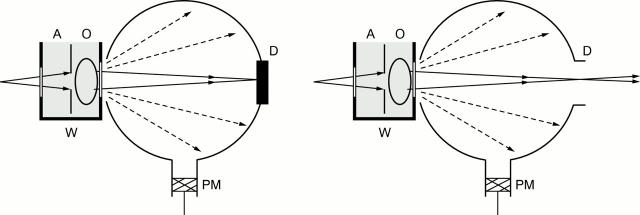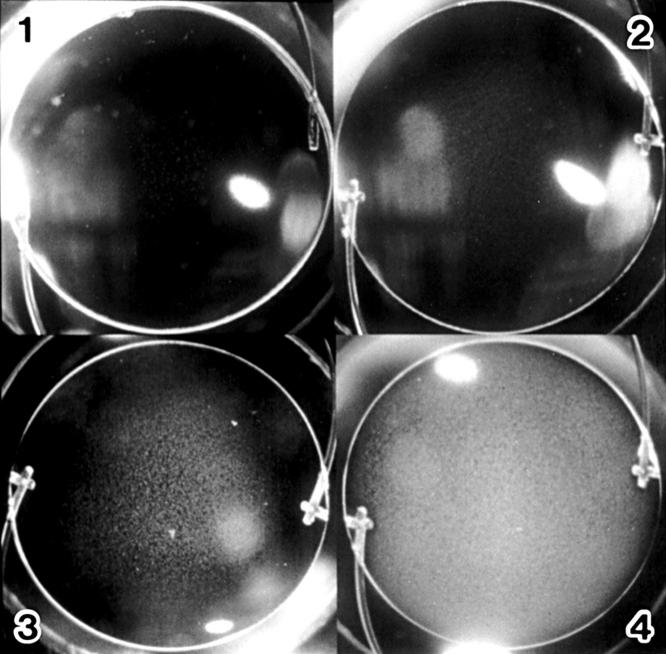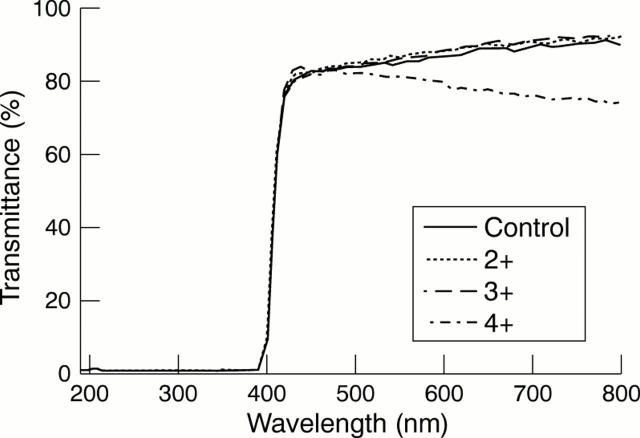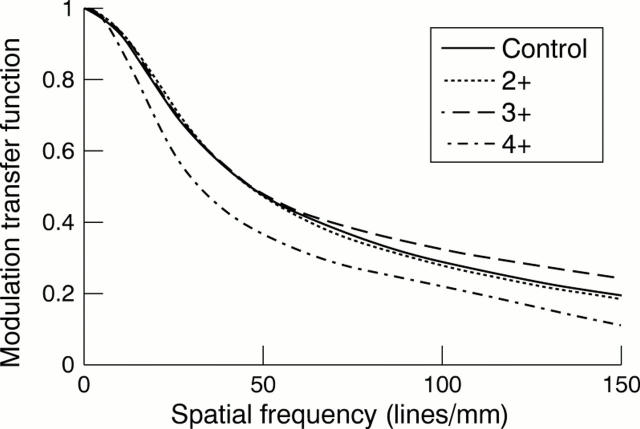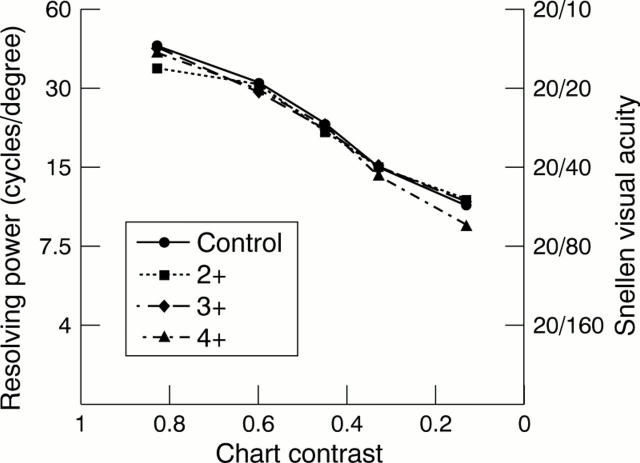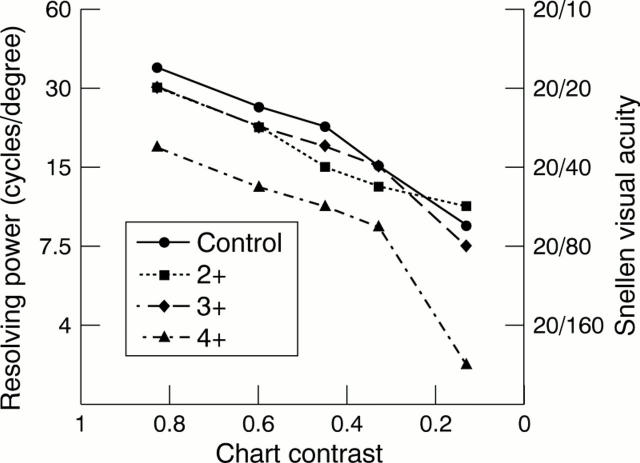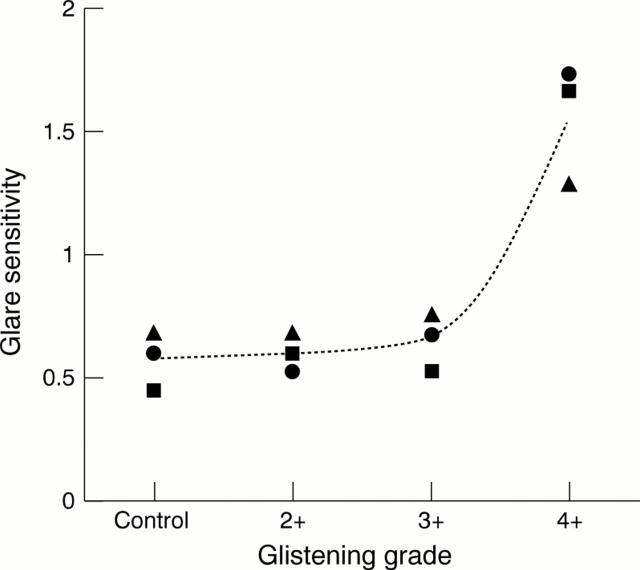Abstract
AIMS—To assess the influence of glistenings on the optical quality of acrylic foldable intraocular lens. METHODS—Several degrees of glistenings in the optic were experimentally created by immersing the lens in water at 37°C for 48 hours and then at 25°C for 24 hours. Optical bench tests were carried out in water including measurements of spectral transmittance with the spectrophotometer, intensity of forward scattering using the integrating sphere photometer, modulation transfer function, and resolving power at various contrasts with and without the veiling glare light source. RESULTS—Glistenings of 1+ to 4+ degrees were created, among which the 4+ glistenings seemed to be extremely intense and thought to be beyond the range of clinical settings. Clinically feasible level of glistenings, up to 3+, did not adversely influence spectral transmittance, scattering, modulation transfer function, and resolving power at various contrasts. The 4+ glistenings caused mild to moderate deteriorations of the optical quality of the lens. CONCLUSION—The optical quality of the acrylic foldable intraocular lens is not significantly affected by the level of glistenings usually seen in the clinical setting.
Full Text
The Full Text of this article is available as a PDF (126.1 KB).
Figure 1 .
Schematic drawing of integrating sphere photometer to measure forward scattering. (Left) The total amount of transmitted light was measured with the rear window closed. (Right) The amount of forward scattering was measured with the rear window open.
Figure 2 .
Optical bench apparatus to measure resolving power of the lens.
Figure 3 .
Slit lamp photograph of glistenings ranging from 1+ to 4+.
Figure 4 .
Spectral transmittance.
Figure 5 .
Modulation transfer function.
Figure 6 .
Resolving power at various contrasts without veiling glare light.
Figure 7 .
Resolving power at various contrasts with veiling glare light on.
Figure 8 .
Glare sensitivity index evaluated by three examiners. The line indicates the average.
Selected References
These references are in PubMed. This may not be the complete list of references from this article.
- Ballin N. Glistenings in injection-molded lens. J Am Intraocul Implant Soc. 1984 Fall;10(4):473–473. doi: 10.1016/s0146-2776(84)80052-x. [DOI] [PubMed] [Google Scholar]
- Chehade M., Elder M. J. Intraocular lens materials and styles: a review. Aust N Z J Ophthalmol. 1997 Nov;25(4):255–263. doi: 10.1111/j.1442-9071.1997.tb01512.x. [DOI] [PubMed] [Google Scholar]
- Dhaliwal D. K., Mamalis N., Olson R. J., Crandall A. S., Zimmerman P., Alldredge O. C., Durcan F. J., Omar O. Visual significance of glistenings seen in the AcrySof intraocular lens. J Cataract Refract Surg. 1996 May;22(4):452–457. doi: 10.1016/s0886-3350(96)80041-1. [DOI] [PubMed] [Google Scholar]
- Dogru M., Tetsumoto K., Tagami Y., Kato K., Nakamae K. Optical and atomic force microscopy of an explanted AcrySof intraocular lens with glistenings. J Cataract Refract Surg. 2000 Apr;26(4):571–575. doi: 10.1016/s0886-3350(99)00342-9. [DOI] [PubMed] [Google Scholar]
- Holladay J. T., Ting A. C., Koester C. J., Portney V., Willis T. R. Intraocular lens resolution in air and water. J Cataract Refract Surg. 1987 Sep;13(5):511–517. doi: 10.1016/s0886-3350(87)80104-9. [DOI] [PubMed] [Google Scholar]
- Holladay J. T., Ting A. C., Koester C. J., Portney V., Willis T. R. Silicone intraocular lens resolution in air and in water. J Cataract Refract Surg. 1988 Nov;14(6):657–659. doi: 10.1016/s0886-3350(88)80035-x. [DOI] [PubMed] [Google Scholar]
- Hollick E. J., Spalton D. J., Ursell P. G., Pande M. V., Barman S. A., Boyce J. F., Tilling K. The effect of polymethylmethacrylate, silicone, and polyacrylic intraocular lenses on posterior capsular opacification 3 years after cataract surgery. Ophthalmology. 1999 Jan;106(1):49–55. doi: 10.1016/S0161-6420(99)90047-7. [DOI] [PubMed] [Google Scholar]
- Hollick E. J., Spalton D. J., Ursell P. G., Pande M. V. Lens epithelial cell regression on the posterior capsule with different intraocular lens materials. Br J Ophthalmol. 1998 Oct;82(10):1182–1188. doi: 10.1136/bjo.82.10.1182. [DOI] [PMC free article] [PubMed] [Google Scholar]
- Klos K. M., Richter R., Schnaudigel O., Ohrloff C. Image analysis of implanted rigid and foldable intraocular lenses in human eyes using Scheimpflug photography. Ophthalmic Res. 1999;31(2):130–133. doi: 10.1159/000055524. [DOI] [PubMed] [Google Scholar]
- Koch D. D., Heit L. E. Discoloration of silicone intraocular lenses. Arch Ophthalmol. 1992 Mar;110(3):319–320. doi: 10.1001/archopht.1992.01080150017007. [DOI] [PubMed] [Google Scholar]
- Leaming D. V. Practice styles and preferences of ASCRS members--1999 survey. J Cataract Refract Surg. 2000 Jun;26(6):913–921. doi: 10.1016/s0886-3350(00)00469-7. [DOI] [PubMed] [Google Scholar]
- Mainster M. A. Spectral transmittance of intraocular lenses and retinal damage from intense light sources. Am J Ophthalmol. 1978 Feb;85(2):167–170. doi: 10.1016/s0002-9394(14)75943-4. [DOI] [PubMed] [Google Scholar]
- Mengual E., García J., Elvira J. C., Ramón Hueso J. Clinical results of AcrySof intraocular lens implantation. J Cataract Refract Surg. 1998 Jan;24(1):114–117. doi: 10.1016/s0886-3350(98)80083-7. [DOI] [PubMed] [Google Scholar]
- Omar O., Pirayesh A., Mamalis N., Olson R. J. In vitro analysis of AcrySof intraocular lens glistenings in AcryPak and Wagon Wheel packaging. J Cataract Refract Surg. 1998 Jan;24(1):107–113. doi: 10.1016/s0886-3350(98)80082-5. [DOI] [PubMed] [Google Scholar]
- Oner F. H., Gunenc U., Ferliel S. T. Posterior capsule opacification after phacoemulsification: foldable acrylic versus poly(methyl methacrylate) intraocular lenses. J Cataract Refract Surg. 2000 May;26(5):722–726. doi: 10.1016/s0886-3350(99)00456-3. [DOI] [PubMed] [Google Scholar]
- Oshika T., Amano S., Araie M., Majima Y., Leaming D. V. Current trends in cataract and refractive surgery in Japan: 1998 survey. Jpn J Ophthalmol. 2000 May-Jun;44(3):268–276. doi: 10.1016/s0021-5155(99)00218-x. [DOI] [PubMed] [Google Scholar]
- Oshika T., Shiokawa Y. Effect of folding on the optical quality of soft acrylic intraocular lenses. J Cataract Refract Surg. 1996;22 (Suppl 2):1360–1364. doi: 10.1016/s0886-3350(96)80098-8. [DOI] [PubMed] [Google Scholar]
- Oshika T., Suzuki Y., Kizaki H., Yaguchi S. Two year clinical study of a soft acrylic intraocular lens. J Cataract Refract Surg. 1996 Jan-Feb;22(1):104–109. doi: 10.1016/s0886-3350(96)80278-1. [DOI] [PubMed] [Google Scholar]
- Peetermans E., Hennekes R. Long-term results of wagon wheel packed acrylic intra-ocular lenses (AcrySof). Bull Soc Belge Ophtalmol. 1999;271:45–48. [PubMed] [Google Scholar]
- Pfoff D. S., Werner J. S. Effect of cataract surgery on contrast sensitivity and glare in patients with 20/50 or better Snellen acuity. J Cataract Refract Surg. 1994 Nov;20(6):620–625. doi: 10.1016/s0886-3350(13)80650-5. [DOI] [PubMed] [Google Scholar]
- Portney V. Optical testing and inspection methodology for modern intraocular lenses. J Cataract Refract Surg. 1992 Nov;18(6):607–613. doi: 10.1016/s0886-3350(13)80453-1. [DOI] [PubMed] [Google Scholar]
- Silicone intraocular lens implant discoloration in humans. Arch Ophthalmol. 1991 Jul;109(7):913–915. [PubMed] [Google Scholar]
- Ursell P. G., Spalton D. J., Pande M. V., Hollick E. J., Barman S., Boyce J., Tilling K. Relationship between intraocular lens biomaterials and posterior capsule opacification. J Cataract Refract Surg. 1998 Mar;24(3):352–360. doi: 10.1016/s0886-3350(98)80323-4. [DOI] [PubMed] [Google Scholar]
- Wang G. J., Pomerantzeff O. A new set of variable-contrast visual acuity charts. Optom Vis Sci. 1991 Jan;68(1):34–40. doi: 10.1097/00006324-199101000-00006. [DOI] [PubMed] [Google Scholar]



